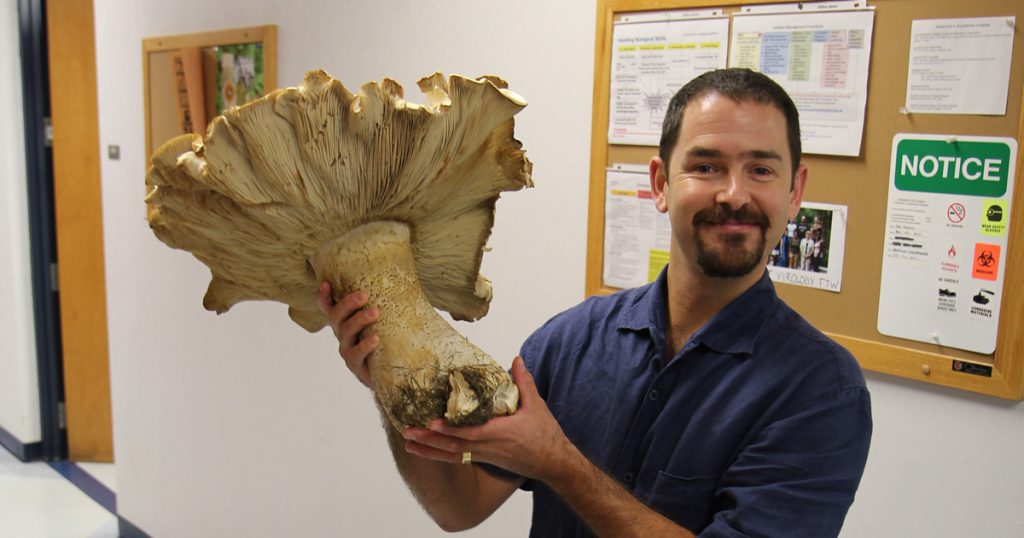Summer is here in Florida, and that means one thing for fungi identification expert Matt Smith.
“More mushrooms, and more questions about mushrooms,” said Smith, an associate professor of plant pathology at UF/IFAS.
The rainy summer months are prime season for mushrooms, which thrive in damp conditions, Smith said.
If you notice more mushrooms popping up in your yard or on your lawn, don’t be alarmed — it’s probably the weather. The mushrooms aren’t hurting your plants, either, Smith said.
“If you spot a mushroom, and you don’t have small children or pets who might eat it, there’s no need to remove it from your yard. Mushrooms are nature’s composters. They break down dead plant matter that’s hard for other organisms to recycle. This helps return nutrients to the soil. And, it’s fun to watch them grow,” Smith said.
That advice to watch and wait is especially applicable to one species of mushroom known only by its scientific name, Macrocybe titans.
The largest mushroom in the Western Hemisphere, Macrocybe titans can grow to be 3 feet across, 1 ½ feet tall, and weigh up to 8 pounds. Typically found in tropical regions of Central and South America, it has been observed in Florida for several decades.

Recently, Elena Karlsen-Ayala, a doctoral student in UF/IFAS College of Agricultural and Life Sciences studying plant pathology, and Smith, her doctoral advisor, found evidence that Macrocybe titans has been spreading into the rest of the southeastern United States ever since it was introduced into South Florida in the 1950s.
“We know there was no recorded sighting of the species before the 1950s in South Florida, and no record of it in north central Florida before the 1970s,” Smith said. “But now, using a new internet database for fungi, we see reports of this mushroom not just in Florida, but also in Texas, Louisiana, Mississippi, Georgia and the Carolinas.”
There are a few possible explanations for the mushroom’s spread, Smith said.
Macrocybe titans grows in areas disturbed by human activity like parking lots and backyards, so the species may have been move around through the transportation of soil and mulch, he said.
“We also suspect that a warming climate may have made it easier for the species, which already does well in tropical climates, to survive farther north,” Smith said.
While the mushroom will likely continue to become more common in the southeast, there isn’t evidence it will start appearing in undisturbed natural areas, Smith said.
“It only seems to survive and grow in areas with human disturbance,” he said.
Smith’s lab offers fungi identification services to the public, including identification of poisonous species. The volume of identification requests is highest during summer, and Smith usually receives a few reports of Macrocybe titans, Smith said.
“People get concerned when they see a really big mushroom in their yard, but there’s no need to be scared,” he said.
“Macrocybe titans is not poisonous, but there are some similar fungi that are toxic,” Smith said. Smith does not recommend eating fungi from the wild unless you are one hundred percent sure of that it is an edible species. “When in doubt, throw it out,” Smith said.
Unlike other mushrooms that seemly pop up overnight, Macrocybe titans grows slowly over several weeks. Its size depends on rainfall. The more rain, the larger the mushroom will grow, Smith said.
“If you find one of these mushrooms, just leave it alone and watch to see how big it will get,” Smith said.
While you’re watching, you might contemplate the fact that scientists still don’t understand how Macrocybe titans’ large size is an evolutionary advantage.
“There is still so much we don’t know about fungi,” Smith said.
 0
0
